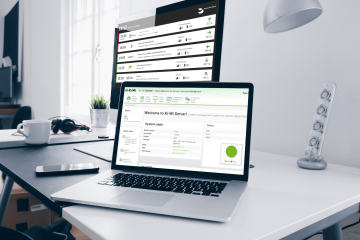When to Choose Ki-Wi Player Windows and When to Choose Ki-Wi Player Light?

Introduction
When selecting a digital signage solution, we often encounter the question of whether to use Ki-Wi Player Windows or Ki-Wi Player Light. Both applications have their advantages and are suitable for different types of projects. In this article, we'll take a closer look at the differences between these two variants and advise you on when it's appropriate to use each of them.
Generally, Ki-Wi Player Light should be the default choice unless the customer needs more advanced features that are only available with Ki-Wi Player Windows. Player Light is easy to install and manage, and is suitable for most common Digital Signage projects. It's the default choice mainly for economic reasons - cheaper hardware running on Android, no need to use an external PC or purchase a Windows license.
When to Choose Ki-Wi Player Windows
Ki-Wi Player Windows is a powerful tool that offers a wide range of advanced features. Here are some situations where it's appropriate to choose this option:
Operating System
- Integration of PC into Active Directory domain: If you need to incorporate the device into a corporate domain for centralized management and security, Ki-Wi Player Windows is the right choice.
- Remote device connection option VNC, AnyDesk: Ki-Wi Player Windows allows remote access to the device using standard remote desktop tools.
Playback Mode
- Combination of content playback on multiple screens: With Ki-Wi Player Windows, you can easily control content on multiple screens simultaneously, for example on a large screen and a smaller touch panel.
- Using one computer for multiple screens: Ki-Wi Player Windows supports controlling multiple screens from one PC, which is useful for video walls and similar installations.
- Support for playback from network folder: Content can be easily managed and updated by multiple users thanks to support for playback from shared network folders.
- Playback of MS PowerPoint (PPTX) files: Ki-Wi Player Windows allows direct playback of PowerPoint presentations without the need for conversion to other formats.
- Dynamic and stack playlists: Advanced playlist creation and management options are available in Ki-Wi Player Windows.
Interactive Mode for Self-Service Terminals / Info Kiosks
- Loading web pages that are not under control: Ki-Wi Player Windows allows displaying any web pages in interactive kiosk mode.
- Kiosk bar: Ki-Wi Player Windows offers the option to add a custom kiosk bar for application control.
- Opening MS Office formats from the kiosk environment: Users can view and work with Microsoft Office documents in kiosk mode.
- Using whitelist for kiosk media: Ki-Wi Player Windows allows restricting access to only allowed websites.
- More complex integration of reader and printer: Advanced integration options for peripherals such as card readers and printers are available in Ki-Wi Player Windows.
When It's Appropriate to Use Ki-Wi Player Light
Ki-Wi Player Light is an ideal choice for simpler Digital Signage projects that don't require the advanced features of Ki-Wi Player Windows. Here are some situations where Ki-Wi Player Light is the right choice:
- Simpler projects without the need for advanced features: If your project doesn't require the advanced features described above, Ki-Wi Player Light will probably be sufficient and easier to implement.
- Screens with built-in Android 7.0 operating system and higher (e.g., Philips Signage): For modern smart screens with Android OS, Ki-Wi Player Light is the natural choice.
Comparison table
| Feature | Light | Windows |
|---|---|---|
| Operating system support | SoC (LG webOS Signage, Samsung SSSP), Android (Philips, Sony, FrameXX, BenQ, etc.), Linux (Raspberry Pi) | Windows |
| Playback of various content formats | ||
| Display of multiple content types on one screen using templates | ||
| Remote control of content playback | ||
| Regular online updates | ||
| Integration into Active Directory domain | ||
| Remote connection using VNC, AnyDesk | ||
| Combination of content playback on multiple screens | Yes, including support for video walls | |
| Playback of MS PowerPoint (PPTX) files | ||
| Advanced playlist creation and management options | Yes, dynamic and stack playlists | |
| Loading any web pages in interactive kiosk mode | ||
| Kiosk bar for application control | ||
| Opening MS Office formats in kiosk mode | ||
| Whitelist to restrict access to allowed websites | ||
| Advanced integration of peripherals (card readers, printers) | Limited options |
Conclusion
When deciding between Ki-Wi Player Windows and Ki-Wi Player Light, it is important to consider the specific requirements of your project. Ki-Wi Player Windows offers a wide range of advanced features, but for many projects, Ki-Wi Player Light will be sufficient and easier to deploy.
If you are unsure which player is best for your project, do not hesitate to contact Ki-Wi support. Our team will be happy to advise you and help you choose the best solution based on your specific needs.
Whether you choose Ki-Wi Player Windows or Ki-Wi Player Light, you can be sure that you will get a reliable and powerful solution for your Digital Signage project.
